The "caves" in the bakery and pastry shop
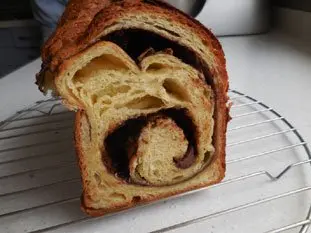
Maybe you've already done this? You want to make a brioche or a cake with fruit inside, you decide to proceed with your usual recipe, but also to add in the dough pieces of fresh and raw fruit, or whole fruit, for example pieces of apples or pears, good idea.
When you bake it, everything seems to go well, you may notice that it puffs up more than usual, but nothing to worry about, on the contrary it's quite good news.
It's only when you cut it that you discover the problem, the pieces of fruit are not surrounded by dough, they are in a kind of cavity of the dough, much bigger than them, and so it's quite ugly all this empty space around, and moreover not very pleasant to taste.
When you bake it, everything seems to go well, you may notice that it puffs up more than usual, but nothing to worry about, on the contrary it's quite good news.
It's only when you cut it that you discover the problem, the pieces of fruit are not surrounded by dough, they are in a kind of cavity of the dough, much bigger than them, and so it's quite ugly all this empty space around, and moreover not very pleasant to taste.
12 K 4.9/5 (17 reviews)
Keywords for this post:PastryBakingCookingBreadCakeHollowBubblesHolesCaveLast modified on: March 27th 2021
The "caves" in the bakery and pastry shop
What happened?
It's very simple, you have intuitively added pieces of fresh and raw fruit which contain a lot of water. During the baking process, this water was transformed into steam by the heat, and this steam, which can't get out, pushed the not yet baked dough, therefore soft, around each piece of fruit, and formed this hollow that the bakers call "cavern". Once the dough is cooked, the cavern remains in place, even when cooling, and therefore gives this unsightly aspect.It happens as soon as you add something containing water to a dough, and it is much more pronounced when it is a leavened dough (brioche, bread, because of or thanks to the gluten network) or flaky dough, and much less on travel cakes (cake, cookies, ...) easier to steam through.
This also applies to salted food for example for a sausage in brioche you would have the same problem.
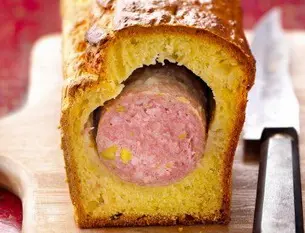
How to avoid this?
There are basically 2 solutions: Either you remove/reduce the water in the first place, or you do something to allow the cooking steam to escape.Removing the water, or at least reducing it is quite simple, for fresh fruit for example we cook them slightly before. For example for apples and pears, in a little butter and sugar, you can even caramelize them, which gives a whole new (delicious) taste to your cake.
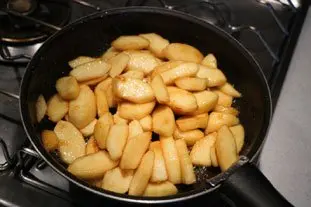
For a sausage, same treatment, either you cook it in the oven, or you poach it before incorporating it.
This is the secret of very aesthetic brioche sausages.
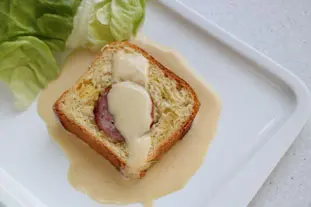
For a galette des rois for example, it is about 2 discs of puff pastry with cream in the middle, we pierce a small hole, the chimney in the center of the galette to allow the steam to escape. Without this chimney you will have in the oven a kind of huge puff pastry bell, and full of emptiness.
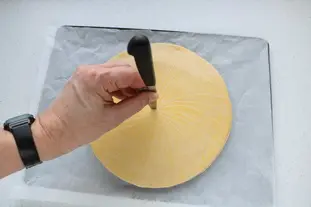
It should be noted that for all this, we are more on a question of aesthetics and mouthfeel, the taste is not impacted.
In summary: To avoid cavities in your cakes, reduce the water brought by your inserts, or provide an outlet for the steam generated during baking.
Lasts posts
Who's making the croissants?
When you look at a bakery from the outside, you naturally think that in the bakery, the bakers make the bread, and in the laboratory, the pastry chefs make the cakes. It's very often like that, with each of these professions having quite different ways of working, but sometimes there's also one...November 23th 2025613
Oven height
When we put a dish or cake in the oven, we naturally tend to put it on the middle shelf, and that's what we usually do. But in some cases, this position and height can be a little tricky, so let's find out why.October 8th 20252,1295
The importance of sieving
In recipes that use a fine powder (flour, powdered sugar, etc.), you'll often see the advice to sift before using it. To sift is to pass the powder in question through a sieve (a very fine strainer) before incorporating it into your recipe. It's often advice, but is it really useful?September 3rd 20257,1733
The grease spray
As soon as you have something in a recipe that sticks to the mold, the question always arises as to how difficult it is to remove from the mold. There's nothing more frustrating than breaking your cake when unmolding it, because part of it has stuck in the mold. The classic way to avoid this is...August 26th 20256,6905
Cake moulds
When we make a cake, or a cake of the same rectangular shape, we usually take out our usual mould and tell ourselves that the recipe is anyway "for a cake", but is it really that simple?August 25th 20256,7295
Other pages you may also like
The bitterness of endives
As I write these lines, we are entering the endive season, and if you like it, it's time to enjoy it, if possible with your local producers. Endive is good, but the reproach that is often made of it, and children in particular, is: "It's bitter! And it is (somewhat) true of course, endives...February 9th 201914 K4.9
Cooking time for pasta
What is as good and simple as pasta? Not much, I think, and it's so easy to prepare: boiling water, salted (or not, depending on your taste), a few minutes of boiling and it's ready. The only "difficulty", so to speak, is the respect of the cooking time and the risk of, unfortunately, overcooking...July 18th 201923 K4.6
How to zest a fruit?
You will have no doubt noticed that many recipes call for the zest of citrus fruit. The zest is that outer layer of the skin which adds so much flavour to a dish. There are many different ways to peel off the zest and various tools are available. Here is a summary of the “dos and don'ts” of...November 5th 201347 K3.8
The first breads of humanity?
I have already told you in a previous article the beautiful story of the croissants, but do you know what it is about the bread, who "invented" it, where and when? Well, you can imagine that recent discoveries, in 2018, have profoundly changed the history of bread.February 16th 201914 K5
Circles vs. moulds tins
If you like to bake or make quiches, pies etc. you must surely have one or more pie pans at home, in different diameters and perhaps materials. They are indispensable, without them there is no way to make beautiful pies, and they work very well, but you have another option, instead of moulds,...October 2nd 202016 K5
Post a comment or question
Follow this page (as 2 people already do)
If you are interested in this page, you can "follow" it, by entering your email address here. You will then receive a notification immediately each time the page is modified or a new comment is added. Please note that you will need to confirm this following.
Note: We'll never share your e-mail address with anyone else.
Alternatively: you can subscribe to the mailing list of cooling-ez.com , you will receive a e-mail for each new recipe published on the site.









